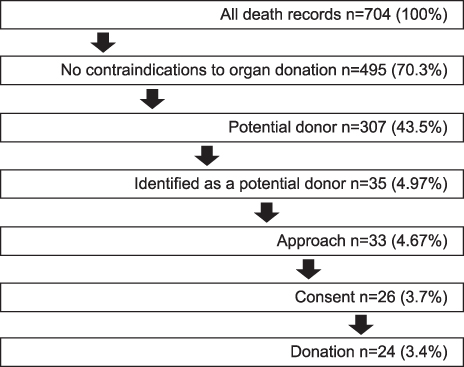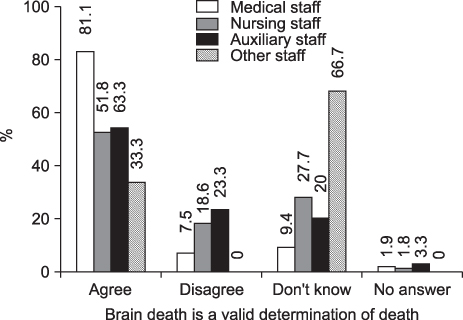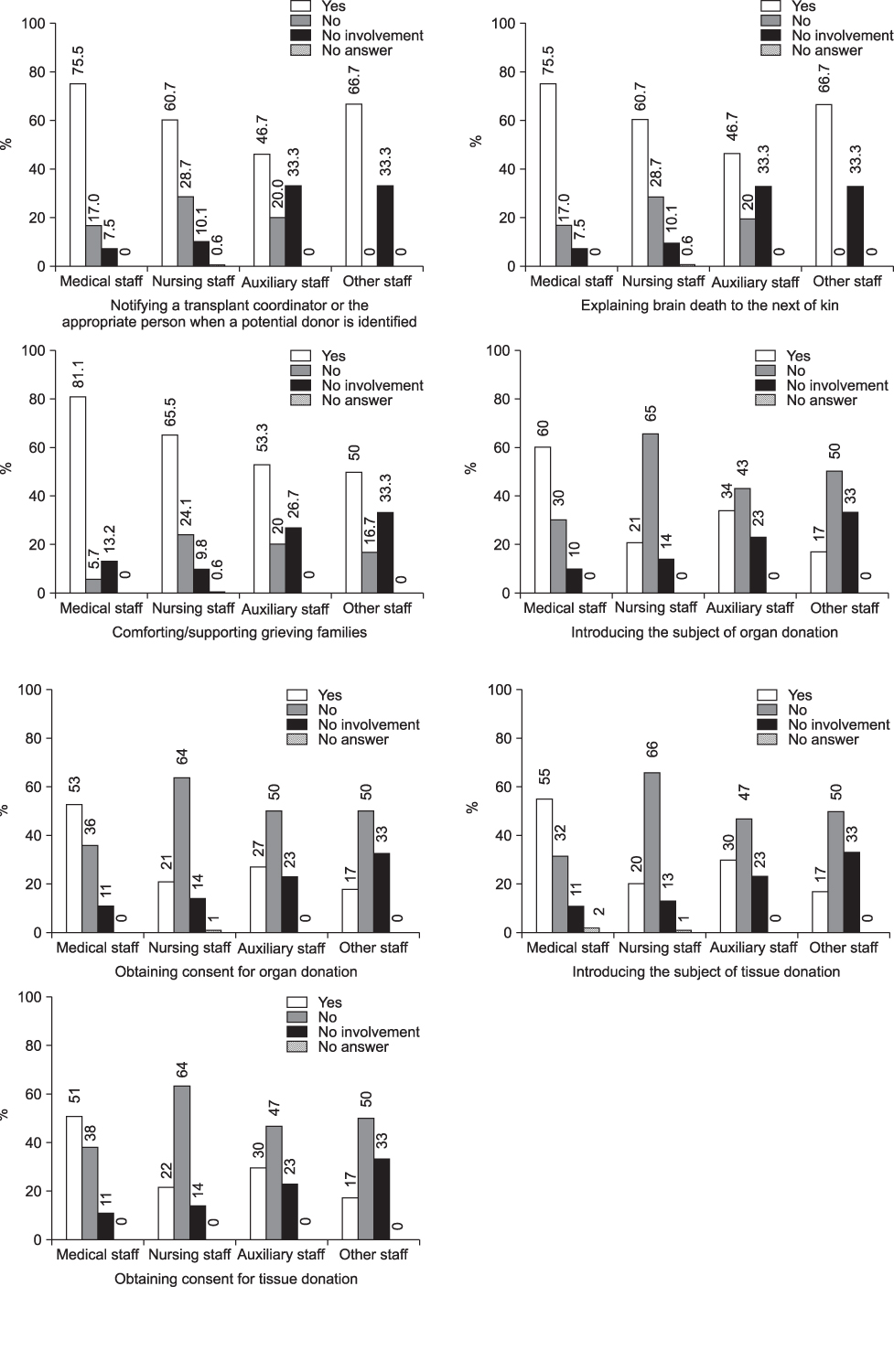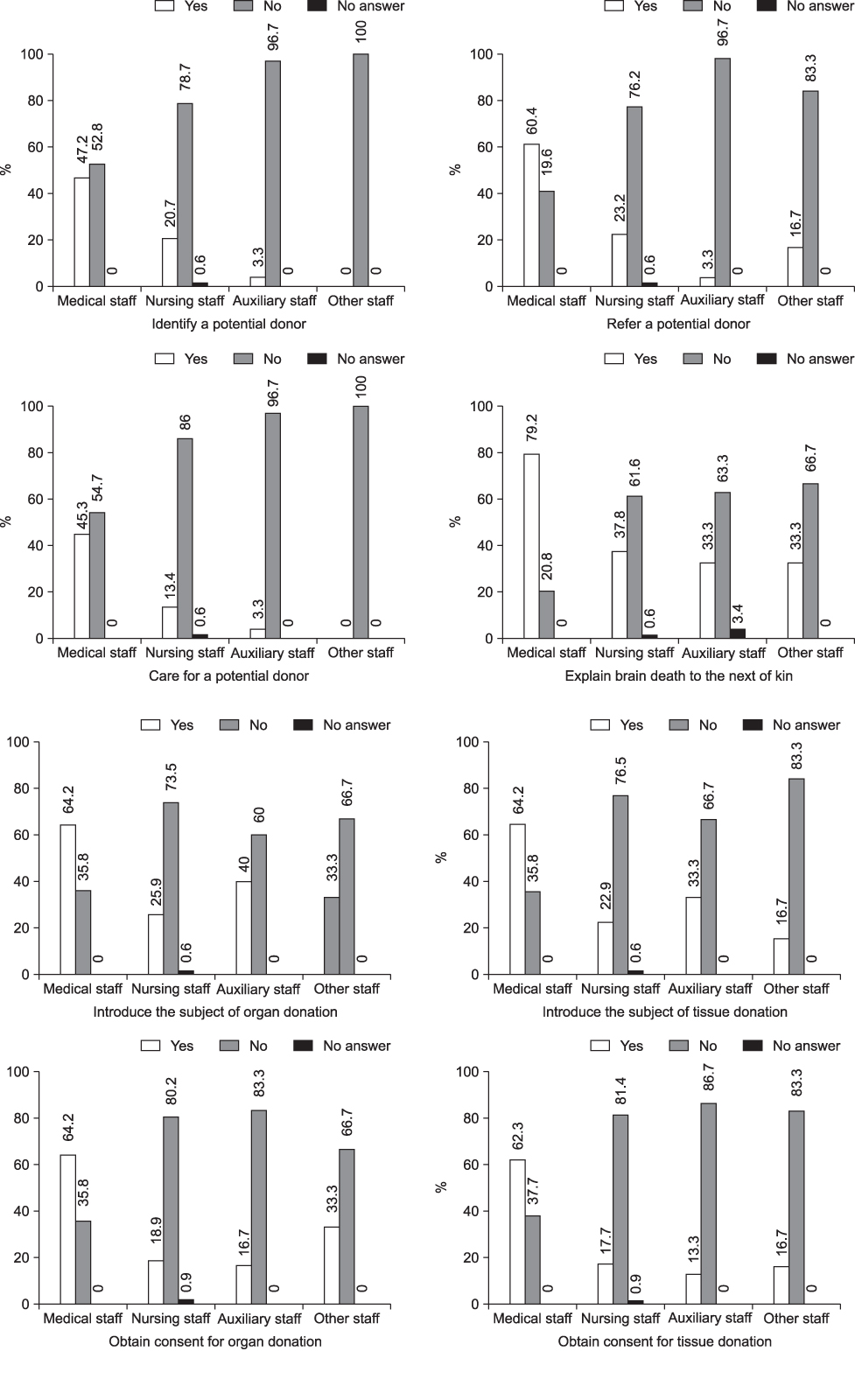J Korean Soc Transplant.
2012 Jun;26(2):101-111.
Preliminary Results of Donor Action in Korea
- Affiliations
-
- 1Organ Transplantation Center, Busan Paik Hospital, Inje University College of Medicine, Busan, Korea. yeonghnl@inje.ac.kr
- 2Division of Transplant and Vascular Surgery, Department of Surgery, Keimyung University School of Medicine, Daegu, Korea.
- 3Department of Donor Action Foundation, Linden, Belgium.
- 4Department of Eurotransplant International Foundation, Leiden, Netherlans.
- 5Korea Organ Donation Agency, Seoul, Korea.
- 6Department of Nephrology, Busan Paik Hospital, Inje University College of Medicine, Busan, Korea.
Abstract
- BACKGROUND
Donor Action (DA) is a well-known program used to evaluate the potential of organ donors and to survey hospital attitudes toward organ donation in a region or nation. DA has not yet been fully implemented in Korea.
METHODS
We collected medical information on expired patients from 9 hospitals in Yeoung-nam province. We also passed out Hospital Attitude Survey questionnaires in those same 9 hospitals. We reviewed the medical records of the expired patients in the neurological and neurosurgical critical care units from January 1, 2009 to December 31, 2009. Data was analyzed with a DA system database.
RESULTS
A total of 704 patients were enrolled. Altogether, 307 patients (43.6%) were potential donors, and 26 patients (6.5%) were reported to an to organ procurement organization. Among the potential donors, a family approach was taken with 33 patients (10.7%), and family consent was obtained in 26 cases (8.5%). Organ donation was done with 24 patients (7.8%). Among the potential donors, 88.6% of them were not identified as potential donors. Hospital attitude surveys were given to 417 hospital staff members. A positive attitude towards organ donation was shown in 85%. However, only 55.4% of hospital staff agreed on the concept of brain death.
CONCLUSIONS
Among the processes of organ donation, identifying a potential donor is a critical step to increase organ donation.
MeSH Terms
Figure
Reference
-
1. Andersen KS, Fox DM. The impact of routine inquiry laws on organ donation. Health Aff (Millwood). 1988. 7:65–78.
Article2. Rithalia A, McDaid C, Suekarran S, Myers L, Sowden A. Impact of presumed consent for organ donation on donation rates: a systematic review. BMJ. 2009. 338:a3162.
Article3. Rithalia A, McDaid C, Suekarran S, Norman G, Myers L, Sowden A. A systematic review of presumed consent systems for deceased organ donation. Health Technol Assess. 2009. 13:iiiix–xi. 1–95.
Article4. Alonso M, Fernández M, Mataix R, Rincón MD, Corrales JA, Burgos R, et al. Donor action in Spain: a program to increase organ donation. Transplant Proc. 1999. 31:1084–1085.
Article5. Wight C, Cohen B, Roels L, Miranda B. Donor Action: a quality assurance program for intensive care units that increases organ donation. J Intensive Care Med. 2000. 15:104–114.
Article6. Roels L, Cohen B, Gachet C, Miranda BS. Joining efforts in tackling the organ shortage: the Donor Action experience. Clin Transpl. 2002. 1:111–120.7. The Donor Action Foundation. Donor Action Program [internet]. 2009. cited 2012 Jan 15. Leiden: DA Foundation;Available from: http://www.donoraction.org.8. Roels L, Spaight C, Smits J, Cohen B. Donation patterns in four European countries: data from the donor action database. Transplantation. 2008. 86:1738–1743.
Article9. Roels L, Spaight C, Smits J, Cohen B. Critical Care staffs' attitudes, confidence levels and educational needs correlate with countries' donation rates: data from the Donor Action database. Transpl Int. 2010. 23:842–850.
Article10. Lee SJ, Park JB, Lyo IU, Sim HB, Song SK, Kwon SC. The organ donation rates in the neurosurgical field: preliminary study in a single institute. J Korean Soc Transplant. 2009. 23:252–256.
Article11. Ojo AO, Hanson JA, Meier-Kriesche H, Okechukwu CN, Wolfe RA, Leichtman AB, et al. Survival in recipients of marginal cadaveric donor kidneys compared with other recipients and wait-listed transplant candidates. J Am Soc Nephrol. 2001. 12:589–597.
Article12. Smits JM, Persijn GG, van Houwelingen HC, Claas FH, Frei U. Evaluation of the Eurotransplant Senior Program. The results of the first year. Am J Transplant. 2002. 2:664–670.
Article13. Cohen B, Smits JM, Haase B, Persijn G, Vanrenterghem Y, Frei U. Expanding the donor pool to increase renal transplantation. Nephrol Dial Transplant. 2005. 20:34–41.
Article14. Frei U, Noeldeke J, Machold-Fabrizii V, Arbogast H, Margreiter R, Fricke L, et al. Prospective age-matching in elderly kidney transplant recipients - a 5-year analysis of the Eurotransplant Senior Program. Am J Transplant. 2008. 8:50–57.15. Cohen J, Ami SB, Ashkenazi T, Singer P. Attitude of health care professionals to brain death: influence on the organ donation process. Clin Transplant. 2008. 22:211–215.
Article16. Bøgh L, Madsen M. Attitudes, knowledge, and proficiency in relation to organ donation: a questionnaire-based analysis in donor hospitals in northern Denmark. Transplant Proc. 2005. 37:3256–3257.
Article17. Blok GA, van Dalen J, Jager KJ, Ryan M, Wijnen RM, Wight C, et al. The European Donor Hospital Education Programme (EDHEP): addressing the training needs of doctors and nurses who break bad news, care for the bereaved, and request donation. Transpl Int. 1999. 12:161–167.
Article18. Blok GA, Morton J, Morley M, Kerckhoffs CC, Kootstra G, van der Vleuten CP. Requesting organ donation: the case of self-efficacy-effects of the European Donor Hospital Education Programme (EDHEP). Adv Health Sci Educ Theory Pract. 2004. 9:261–282.
Article19. Pugliese MR, Degli Esposti D, Dormi A, Venturoli N, Mazzetti Gaito P, Buscaroli A, et al. Improving donor identification with the Donor Action programme. Transpl Int. 2003. 16:21–25.
Article20. Lee S, Ahn C, Kim SI, Han DJ, Cho WH. Analysis of the potential deceased donors in the neurosurgical intensive care units of Korea. J Korean Soc Transplant. 2011. 25:106–112.
Article21. Lee SM, Lee YH, Kim SH, Kim SY. Study on perceptions and attitudes of Koreans on organ donation. J Korean Soc Transplant. 2003. 17:227–233.22. Ha HS, Hong JJ, Kim SC, Lee SG, Song MG, Han DJ. Study on physician's perceptions and attitudes on organ donation in brain dead donors. J Korean Soc Transplant. 2001. 15:51–57.
- Full Text Links
- Actions
-
Cited
- CITED
-
- Close
- Share
- Similar articles
-
- A Preliminary Study to Revise the Marginal Donor Criteria of KONOS in Deceased Donor Kidney Transplantation
- Program to Activate the Notification of the Potential Donors
- The Role of NGO in Deceased Organ Transplantation
- Living Donor Exchange Program for Adult Living Donor Liver Transplantation: Preliminary Experience at the Asan Medical Center, Korea
- Thrombotic microangiopathy, rare cause of deceased donor acute kidney injury: is a donor biopsy necessary before donation?








